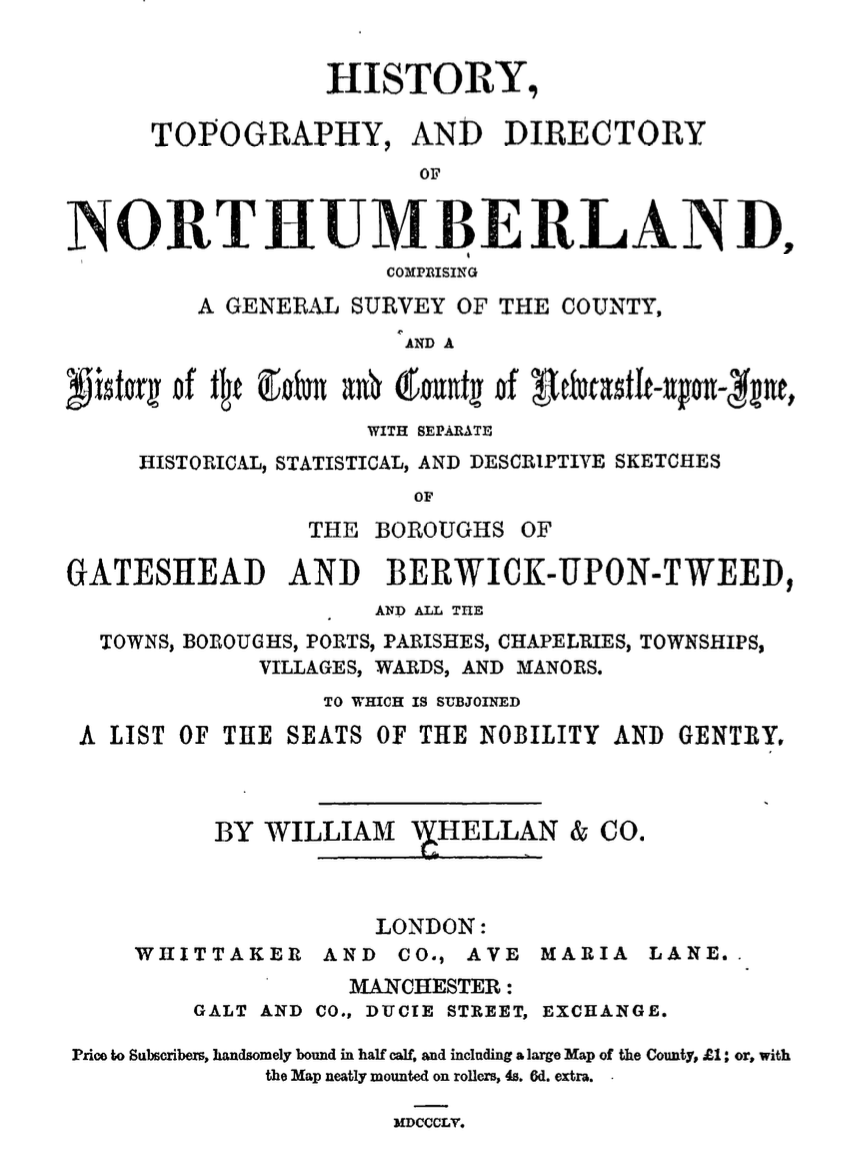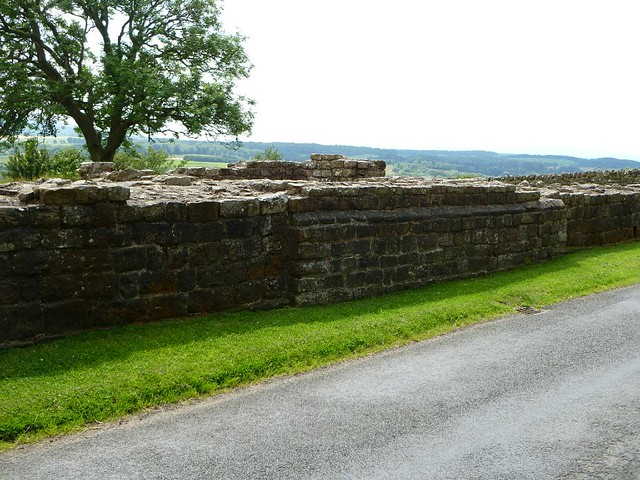Topics > Northumberland > Civil Parishes in Northumberland > Alnwick Town Council area > Alnwick Parish, 1855 > Borough of Alnwick History
Borough of Alnwick History
Extract from: History, Topography, and Directory of Northumberland...Whellan, William, & Co, 1855.
BOROUGH OF ALNWICK
ALNWICK, the county town of Northumberland, is situated on a declivity near the banks of the Aln, about thirty-three miles north by west of Newcastle, and 306 north by west of London. The population in 1851 amounted to 6,231 souls, of which 2,882 were males, and 3,348 females. The town is well built, the houses are modern, and in general constructed of freestone, many of them are of considerable elegance. Four bridges cross the Aln in the neighbourhood of the town, one of which, situated at the northern extremity, is a fine stone structure of three arches. The streets are well paved, spacious, and lighted with gas. Alnwick had formerly four gates, defended by massive towers, of which Bondgate is the only one remaining, and is at present used as a prison. There is a spacious Market Place and Town Hall, in which the courts for the county are held, and the members of parliament for the northern division of the county are elected. The most important building is the Castle, to which we shall devote a separate article.
History is silent with regard to the foundation and rise of the town of Alnwick, though it is the opinion of antiquarians that it owes its origin to the Romans, but it is certain that it was inhabited during the Saxon period of our history, and that Gilbert Tyson, one of the most powerful of the Northumbrian chiefs, was the proprietor of the castle at the time of the Norman Conquest. Few remains of antiquity are found in the neighbourhood, and hence it has been inferred, that the various armies, which at different periods invaded the country, did not remain in this place for any length of time. In the reign of Rufus, the town. was besieged by Malcolm III. of Scotland, who was killed along with his son before its walls. It was captured by David of Scotland in the year 1135, but was restored to the English crown by treaty in the following year. Alnwick appears to have been very inauspicious to the Scottish kings, for William the Lion was taken prisoner here, while besieging the castle in 1174. It is related that William, attended by sixty followers, was engaged in tilting at a short distance to the west of the Castle, when he was suddenly attacked by a party of horsemen, who had advanced from Newcastle to the relief of the place. At their first appearance, he mistook them for a party of his own men, but on seeing their banner, he struck his shield with his lance, and rode forward to encounter them, exclaiming, "Now let us prove who is the truest knight." His horse was killed at the first shock, and he himself thrown to the ground and made prisoner. About a quarter of a mile from the Castle, to the left of the road going to Hulne Park, there is a stone set up near the spot where tradition says the king was captured. The Scottish monarch was subsequently ransomed for the sum of £100,000. Alexander, the son of William the Lion, came to Alnwick in 1210, to render homage to king John, and five years afterwards the barons of the north had resource to the same Alexander for protection against the tyranny of the English monarch, and in order to obtain it did homage to Alexander at Felton. This proceeding so incensed John, that he marched northward in the depth of winter, and caused Alnwick and several other towns to be laid in ashes. It was again destroyed by fire in the year 1448, by the Scots under the command of James Douglas, Lord of Balveny. In the reign of Edward IV., the English army commanded by the Dukes of Albany and Gloucester, was marshalled at Alnwick, previous to an invasion of Scotland; and in the reign pf Henry VIII., 1543, a few days previous to the memorable battle of Flodden, wherein James IV. of Scotland lost his life, an army of 26,000 men was detained at Alnwick for some time, in consequence of the heavy rains which rendered the roads impassable.
The renowned house of Percy, which may number among its ensigns those of the royal lines of England and Scotland, of Normandy and Brittany, of France, Castile, and Leon, had its origin in Denmark, being descended from Mainfred, a Danish noble; who united with Rollo in the subjugation of Normandy, in 912, and adopted the name of De Percy from his acquired possessions in that province. Sixth in descent from him was William de Percy, who came over with the Conqueror and married Emma, daughter of Cospatric, the Saxon Earl of Northumberland, whose estates had been seized and conferred upon the Percy, for the war their owner levied against the Normans. Sir Henry Percy, the renowned "Hotspur," was. eldest son of Henry, fourth Baron of Alnwick, and first Earl of Northumberland, and was father of the second earl. The sixth earl was persecuted by Henry VIII. for his early attachment to Anne Boleyn, and died without issue, when the honours were conferred upon his nephew, Thomas, by Queen Mary. This Thomas, Earl of Northumberland, was one of the Wardens General of the Marches, and defeated the Scotch in two engagements, near Cheviot and Swinton, in 1557, and the following year. He was one of the lords who protested against the validity of Anglican ordinations, and in concert with the Earl of Westmoreland, headed an insurrection in the north which had for its object the restoration of the old religion. The undertaking, however, failed, and, the Earl of Northumberland was beheaded at York. He was succeeded by his brother Henry, who had remained, during the insurrection, a firm adherent of Elizabeth. He was summoned to the parliament held in 1576, by the title of Earl of Northumberland and Baron Percy, but being suspected of plotting to place Mary, Queen of Scots, upon the English throne, he was committed to the Tower, where he was found dead in his bed, on the 21st June, 1585. Henry, his eldest son, the ninth Earl, succeeded him, and was one of those volunteer lords who hired vessels to accompany Charles Howard, Lord High Admiral of England, against the Spanish Armada, but, on a bare suspicion of being implicated in the Gunpowder Plot, he was severely fined and imprisoned. He afterwards arraigned before the Star Chamber, by whose sentence he was tined three hundred thousand pounds, rendered incapable of holding office, and sentenced to perpetual imprisonment. In the Tower he devoted himself to literary and scientific pursuits, pensioned several learned men and was accustomed to have so many mathematicians and scientific men at his table that he was surnamed " Henry the 'Wizard." His liberal patronage of science has won for him a prouder title, that of the Moecenas of his age. Having paid the enormous fine imposed upon him, he regained his liberty in 1621, and died at his seat at Petworth, in 1632, leaving six children, the two eldest of whom dying without issue, he was succeeded by his third son, Algernon, who became the tenth Earl of Northumberland. This Algernon was about thirty years of age when the titles and estates of his ancestors devolved upon him. He acted under several commissions from the parliament, during the civil war, and made every effort to save the life of the king. He subsequently took an active part in the restoration of Charles II, and dying at Petworth, in. 1668, was succeeded by his only son Josoeline, who was afterwards Lord Lieutenant of the Counties of Northumberland and Sussex. He died in 1670, leaving an only child, the Lady Elizabeth Percy, heiress, with his large possessions, to the baronies only, the other honours becoming extinct. She married, thirdly, (having been twice a widow and thrice a wife before she was sixteen years of age), Charles Seymour, Duka of Somerset, who assumed her name, and their son, Algernon Seymour, Earl of Hertford and Egremont, and eighth Duke of Somerset, succeeded his father as Baron Percy; and was created Earl of Northumberland, with remainder to the husband of his only child, the Lady Elizabeth, who married Sir Hugh Smithson, Bart., of Stamoick, in the County of York. This lady succeeded as Baroness Percy, and Sir Hugh as Earl of Northumberland, and Baron Warkworth. He assumed the name of Percy, and was created Baron Louvaine, of Alnwick, Earl Percy, and Duke of Northumberland, which dignities he enjoyed till his death, in 1786, when they were inherited by his eldest son, who dying in 1817, in the 75th year of his age, was succeeded by his eldest son, Hugh Percy, third Duke of Northumberland, upon whose demise, in 1847, the estates and honours of this ancient house were inherited by his brother, Algernon Percy, the present Duke of Northumberland, Earl of Northumberland, Earl Percy, Baron Percy, Baron Lucy, Baron Fitzpayne, Poynings, Bryan, Latimer, Warkworth, and Prudhoe. His grace is a Knight of the Garter, and was First Lord of the Admiralty in the Earl of Derby's Cabinet. The Duke is also a retired rear admiral in the royal navy, constable of Launceston Castle, president of the Royal Institution, a privy councillor, D.C.L., and F.R.S.










